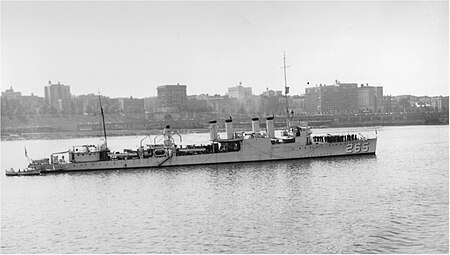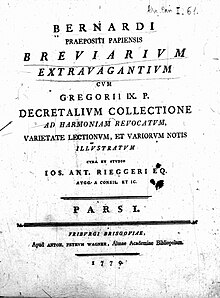Decretal
|
Read other articles:

Голубянки Самец голубянки икар Научная классификация Домен:ЭукариотыЦарство:ЖивотныеПодцарство:ЭуметазоиБез ранга:Двусторонне-симметричныеБез ранга:ПервичноротыеБез ранга:ЛиняющиеБез ранга:PanarthropodaТип:ЧленистоногиеПодтип:ТрахейнодышащиеНадкласс:ШестиногиеКласс:Н�…

Rehovot (he) רחובות - (ar) رحوبوت Héraldique Administration Pays Israël District District centre Maire Matan Dil (2024 - ) Démographie Population 152 084 hab. (2022) Densité 6 601 hab./km2 Géographie Coordonnées 31° 53′ 00″ nord, 34° 48′ 00″ est Superficie 2 304,1 ha = 23,041 km2 Divers Date de création 1890 Localisation Géolocalisation sur la carte : Israël Rehovot Géolocali…

Clemson-class destroyer For other ships with the same name, see USS Edwards. History United States NameUSS Edwards NamesakeWilliam W. Edwards BuilderBethlehem Shipbuilding Corporation, Squantum Victory Yard Laid down3 June 1918 Launched10 October 1918 Commissioned24 April 1919 Decommissioned8 October 1940 Stricken8 January 1941 IdentificationDD-265 FateTransferred to U.K., 8 October 1940 United Kingdom NameHMS Buxton Acquired8 October 1940 Commissioned8 October 1940 IdentificationH96 Honours and…

Premier of New Brunswick since 2018 The HonourableBlaine HiggsMLAHiggs in 202434th Premier of New BrunswickIncumbentAssumed office November 9, 2018MonarchsElizabeth IICharles IIILieutenant GovernorJocelyne Roy-VienneauBrenda MurphyDeputyRobert Gauvin (2018–20)Preceded byBrian GallantLeader of the OppositionIn officeOctober 22, 2016 – November 9, 2018Preceded byBruce FitchSucceeded byBrian GallantLeader of the Progressive Conservative Party of New BrunswickIncumbentAssumed office…

Rizzoli & IslesLogo della serie televisivaTitolo originaleRizzoli & Isles PaeseStati Uniti d'America Anno2010-2016 Formatoserie TV Generecommedia drammatica, poliziesco, commedia, sentimentale, azione Stagioni7 Episodi105 Durata45-55 min (episodio) Lingua originaleinglese Rapporto16:9 CreditiIdeatoreJanet Tamaro, Tess Gerritsen Interpreti e personaggi Angie Harmon: Jane Rizzoli Sasha Alexander: Dr. Maura Isles Lee Thompson Young: Barry Frost Bruce McGill: Vince Korsak Jor…

Independência totalB. Indonesia: Kemerdekaan totalLagu kebangsaan Sao Tome dan PrincipePenulis lirikAlda Neves da Graça do Espírito SantoKomponisManuel dos Santos Barreto de Sousa e AlmeidaPenggunaan1975 Independência total (bahasa Indonesia: Kemerdekaan total) adalah lagu kebangsaan Sao Tome dan Principe. Lagu ini diadopsi tahun 1975 setelah Sao Tome dan Principe berhasil mencapai kemerdekaannya dari Portugal. Liriknya ditulis oleh Alda Neves da Graça do Espírito Santo (1926–…

Not to be confused with Dairy. Regency in North Sumatra, IndonesiaDairi RegencyRegencyRegent's office of Dairi Regency Coat of armsCountryIndonesiaProvinceNorth SumatraRegency seatSidikalangGovernment • RegentEddy Keleng Ate Berutu • Vice RegentJimmy Andrea Lukita Sihombing • Chairman of Council of RepresentativesSabam Sibarani (Golkar) • Vice Chairmen of Council of RepresentativesAlvensius Tondang (PDI-P) and Wanseptember Situmorang (Partai Demokr…

Town square in Hilo, Hawaii Kalākaua ParkKalakaua Park, with the view of the Federal Building and U.S. Post Office (ZIP 96721) across Waianuenue Ave.Nearest cityHilo, HawaiiCoordinates19°43′31″N 155°05′19″W / 19.72528°N 155.08861°W / 19.72528; -155.08861Created1934 Kalākaua Park is the central town square of the city of Hilo, Hawaii. It is surrounded by historic buildings and includes a war memorial. History The sundial donated by King Kalakaua The area…

Vous lisez un « bon article » labellisé en 2008. La première page de la Chronique de Peterborough. La Chronique anglo-saxonne (anglais : Anglo-Saxon Chronicle) est un ensemble d'annales en vieil anglais relatant l'histoire des Anglo-Saxons. Leur rédaction débute dans le royaume de Wessex sous le règne d'Alfred le Grand, à la fin du IXe siècle. De multiples copies des annales sont distribuées aux monastères d'Angleterre et ensuite mises à jour indépendamment les u…

Italian statesman (1881–1954) Alcide De GasperiDe Gasperi in 1953Prime Minister of ItalyIn office10 December 1945 – 17 August 1953President Enrico De Nicola Luigi Einaudi Monarchs Vittorio Emanuele III Umberto II Lieutenant GeneralThe Prince of PiedmontDeputy Luigi Einaudi Randolfo Pacciardi Giuseppe Saragat Attilio Piccioni Giovanni Porzio Preceded byFerruccio ParriSucceeded byGiuseppe PellaPresident of the Common AssemblyIn office11 May 1954 – 19 August 1954Preceded…

American journalist Jeffrey GettlemanBorn (1971-07-22) July 22, 1971 (age 52)Chicago, Illinois, U.S.EducationCornell University (AB)University of Oxford (MA)OccupationJournalistNotable credit(s)The New York Times, Los Angeles Times, St. Petersburg Times, CherwellSpouseCourtenay Morris (m. 2005) Jeffrey A. Gettleman (born 1971) is an American Pulitzer Prize-winning journalist. Since 2018, he has been the South Asia bureau chief of The New York Times based in New Delhi.[1] From 2006 t…

Halaman ini berisi artikel tentang hari unjuk rasa pro-Palestina tahunan. Untuk hari libur nasional Israel, lihat Hari Yerusalem. Hari QudsHari Quds di TehranDirayakan olehIran, dan negara dan komunitas lainJenisIdeologiMaknaUnjuk rasa melawan Zionisme, pemerintahan Israel dan pendudukan Yerusalem; solidaritas dengan bangsa PalestinaMulaiJumat Terakhir dari bulan RamadanFrekuensiTahunanTerkait denganRevolusi IranNasionalisme PalestinaAnti-Zionisme Hari Quds (Hari Yerusalem; Quds adalah nama Arab…

List of events ← 1829 1828 1827 1830 in India → 1831 1832 1833 Centuries: 17th 18th 19th 20th 21st Decades: 1810s 1820s 1830s 1840s 1850s See also:List of years in IndiaTimeline of Indian history Events in the year 1830 in India. Events National income - ₹9,100 million Mysore rebellion.[1] Scottish Church College[2] Thuggee and Dacoity Department[3] Vellore Central Prison[4] Law Illusory Appointments Act (British statute) Debts Recovery Act (British …

This article needs to be updated. Please help update this article to reflect recent events or newly available information. (August 2021) COVID-19 pandemic in NebraskaCollecting COVID-19 test samples at the Sarpy County Fairgrounds in Springfield DiseaseCOVID-19Virus strainSARS-CoV-2LocationNebraska, U.S.First outbreakWuhan, ChinaIndex caseOmahaArrival dateMarch 6, 2020Confirmed cases475,690 [1]Hospitalized cases6,411Recovered166,944Deaths3,986 [1]Government websiteNebraska Depart…

هذه المقالة يتيمة إذ تصل إليها مقالات أخرى قليلة جدًا. فضلًا، ساعد بإضافة وصلة إليها في مقالات متعلقة بها. (أبريل 2016) يفتقر محتوى هذه المقالة إلى الاستشهاد بمصادر. فضلاً، ساهم في تطوير هذه المقالة من خلال إضافة مصادر موثوق بها. أي معلومات غير موثقة يمكن التشكيك بها وإزالتها. (م…

Questa voce o sezione sull'argomento centri abitati della Lombardia non cita le fonti necessarie o quelle presenti sono insufficienti. Puoi migliorare questa voce aggiungendo citazioni da fonti attendibili secondo le linee guida sull'uso delle fonti. Segui i suggerimenti del progetto di riferimento. Villasantacomune Villasanta – Veduta LocalizzazioneStato Italia Regione Lombardia Provincia Monza e Brianza AmministrazioneSindacoLuca Ornago (lista civica) dal 25-5-2…

Ne doit pas être confondu avec Marie Walewska. Cet article est une ébauche concernant un film américain. Vous pouvez partager vos connaissances en l’améliorant (comment ?) selon les conventions filmographiques. Marie Walewska Données clés Titre original Conquest Réalisation Clarence BrownGustav Machatý (non crédité) Scénario S. N. BehrmanSamuel HoffensteinSalka Viertel Acteurs principaux Greta GarboCharles Boyer Sociétés de production Metro-Goldwyn-Mayer Pays de production É…

Cet article est une ébauche concernant une localité hongroise. Vous pouvez partager vos connaissances en l’améliorant (comment ?) selon les recommandations des projets correspondants. Tarnaszentmária Blason de Tarnaszentmária Tarnaszentmária Tarnaszentmária Administration Pays Hongrie Comitat (megye) Heves (Hongrie septentrionale) District (járás) Eger Rang Commune Bourgmestre(polgármester) Mandat Czipó István László (indépendant) (2014-2019) Code postal 3331 Indicatif tél…

American governmental official (1896–1974) Lewis StraussStrauss in 1962United States Secretary of CommerceActingIn officeNovember 13, 1958 – June 30, 1959PresidentDwight D. EisenhowerPreceded bySinclair WeeksSucceeded byFrederick H. MuellerChair of the United States Atomic Energy CommissionIn officeJuly 2, 1953 – June 30, 1958PresidentDwight D. EisenhowerPreceded byGordon DeanSucceeded byJohn A. McConeMember of the United States Atomic Energy CommissionIn officeNovember 1…

For hardware accelerators in startup companies, see Seed accelerator. Specialized computer hardware This article needs additional citations for verification. Please help improve this article by adding citations to reliable sources. Unsourced material may be challenged and removed.Find sources: Hardware acceleration – news · newspapers · books · scholar · JSTOR (September 2014) (Learn how and when to remove this message) A cryptographic accelerator card al…


